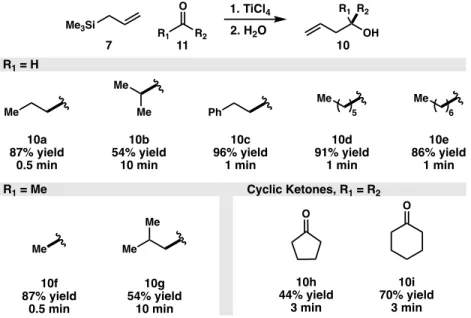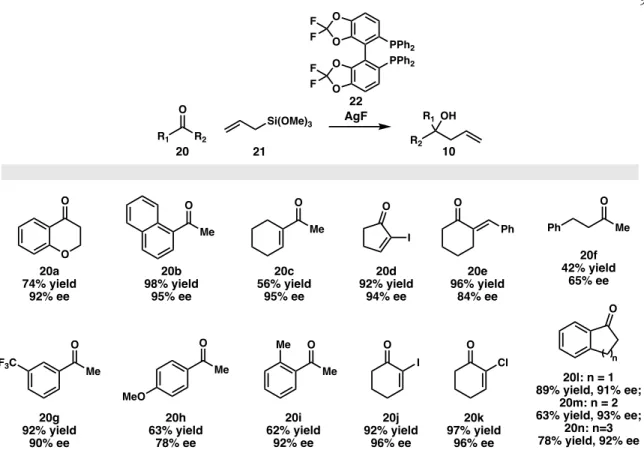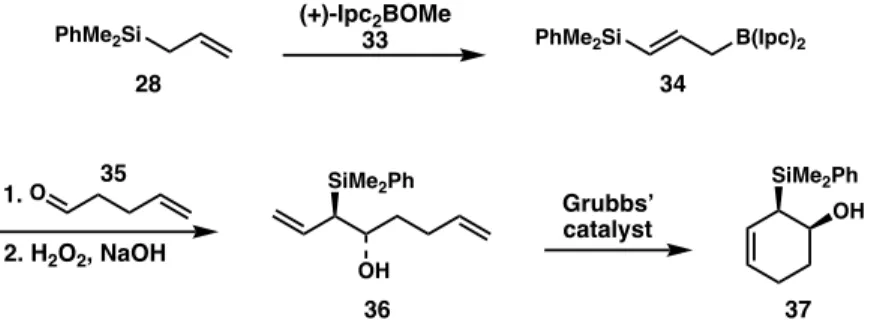Background on Allylic Silanes
Organosilanes as Tools in Organic Synthesis
In some cases, replacing a carbon atom with a silicon atom has been shown to improve the therapeutic effects of known drugs 1-3 (Figure 1).1 While the atoms have similar electronic properties, there are subtle differences between them, e.g. increased C–Si bond length compared to C–C. In order to synthesize complex organic compounds such as the bioactive molecules (1-3) in Figure 1, the synthetic organic chemist must construct these molecules step by step, relying on the reactions available to them from their synthetic toolkit.
Reactivity of Allylic Silanes with Electrophiles
More specifically, the carbon-silicon σ bond in the case of allylic silanes shows conjugation with the π bond of the olefin.7 This electronic structure increases the energy of the highest occupied molecular orbital and therefore allylic silane motifs (4) can be very strong . reactive with electrophiles, forming carbocation intermediate 5 en route to 6 (Figure 2). In addition, allylic silanes do not easily isomerize like their allyl metal counterparts; this isomerization only occurs at temperatures of 500 °C, making reactions of allylic silanes with electrophiles region-specific, unlike other allyl metal compounds.8.
Leveraging Reactivity to Make Stereospecific Transformations
When exposed to the Lewis acid for extended periods, the yield of the desired product decreases due to side reactions such as polymerization. While the Sakurai allylation provides a robust method to prepare alcohols from the acid-catalyzed reaction between allylic silanes and carbonyl compounds, the value of the alcohol product is often overlooked.

Alternate and Optimal Reaction Conditions
A shortcoming of the Sakurai allylation reaction is that it requires stoichiometric amounts of Lewis acid to activate the carbonyl species present in the reaction mixture. Therefore, it is desirable to develop processes using catalytic amounts of the Lewis acid.
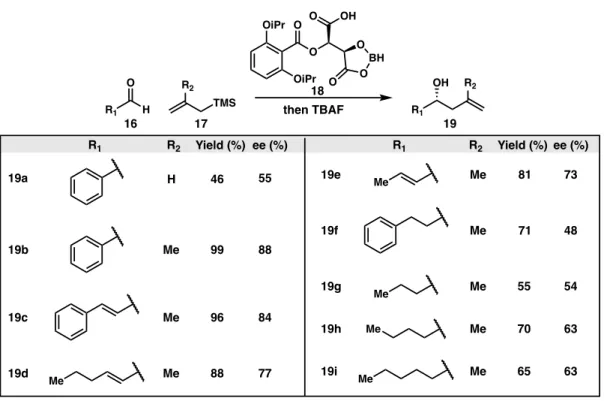
The Sakurai Allylation in Total Syntheses
Williams' use of the Sakurai allylation has poor diastereocontrol, but the undesired isomer can be reversed with a Mitsunobu reaction. The diastereoselective Sakurai allylation of the core with allyltrimethylsilane (7) was able to introduce the alcohol stereocenter with moderate selectivity (dr 4:1).

Other Reactions Between Allylic Silanes and Aldehydes
Similarly, chiral organoborane compounds can be used in place of a chiral titanium complex to prepare chiral hydroxysilanes in excellent yields. The synthesis of chiral β-hydroxyallyl silanes can undergo ring-closing metathesis to a cyclic form, starting from a γ-silyl allyl borate intermediate.
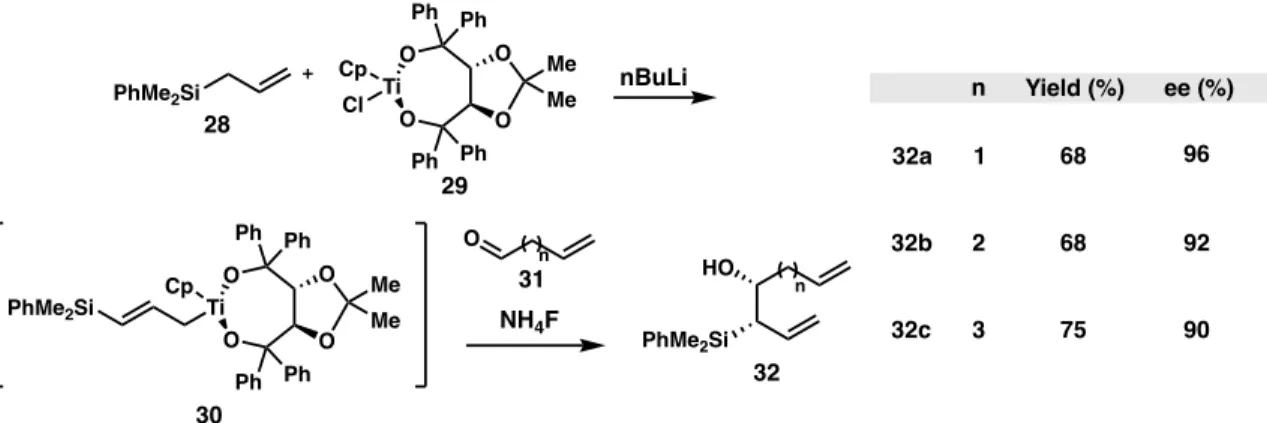
Selected Methods to Synthesize Chiral Allylic Silanes
- Stereospecific Approaches
- Stereoselective Approaches
All previous methods exploit the chirality of the starting material in order to produce enantioenriched allylic silanes through stereospecific transformations. This lack of modularity prevents this reaction from being universally applicable in the synthesis of chiral allylic silanes from simple starting materials.

Cross-Coupling as a Modular Approach to Chiral Allylic Silanes
Second, we suggested that the reaction conditions were too acidic and rapid protonation of the alkoxide intermediate inhibited cyclization to the heterocycle. With this knowledge of the proposed mechanism, we briefly attempted to make the reaction catalytic.
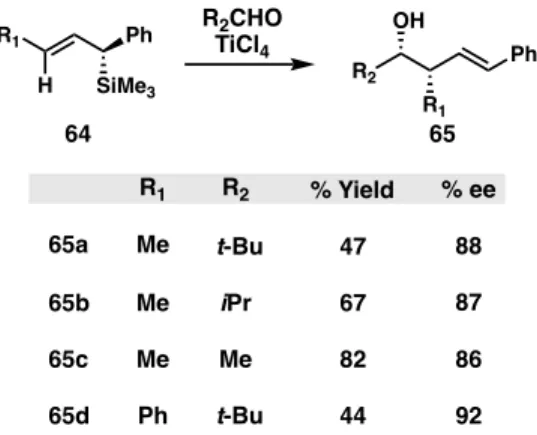
Reaction Design and Results
Conception and Basis for Reactivity
Asymmetric reductive cross-coupling between silyl-substituted benzyl chlorides and vinyl bromides to provide access to chiral allylic silanes. Starting from chiral allylic silanes, we propose that cyclization to five- and six-membered heterocyclic rings can be achieved.

Initial Screening of Lewis Acids
In addition, the alcohol intermediate decomposed once the reaction warmed to room temperature, so we circumvented this problem by running the reaction again and quenching with water at –78°C. The reaction was quenched with water before warming to room temperature, which reduced the decomposition of the alcohol.

Screening of Additives to Promote Cyclization
With the addition of a mild base, 2,6-lutidine (95), the desired tetrahydropyran was observed in only 2% yield. Compared to the series without any additions, there was no improvement due to the addition of a crown or a mild base. However, with five equivalents of potassium tert -butoxide, the reaction successfully produced the desired tetrahydropyran: only 1% yield of alcohol remained and a 69% yield of the desired product was obtained.
This suggests that the problem with cyclization may be related to the displacement of the chlorides from titanium while coordinated to the oxygen atom (Figure 32). If the remaining three chlorides can be displaced, titanium can dissociate from the oxygen atom with a fourth equivalent of base and produce the desired cyclic product (90). If this is the case, only four equivalents of potassium tert-butoxide are required to cause cyclization.
This Lewis acid already has large alkoxide groups coordinated to titanium, which can make the reaction catalytic by recycling the Lewis acid in the reaction. 95 96. equiv) amount of titanium isopropoxide, the reaction failed to produce any allylated product and only the starting material was recovered.
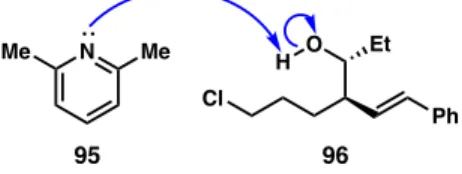
Applying the Method to Tetrahydrofurans
To prepare the required allylsilane starting material, we performed the nickel-catalyzed cross-coupling with a vinyl bromide containing one less methylene group than in our previous methods. With the allylic silane in hand, we can begin our efforts to optimize the reaction to workbench procedures such that it can be a practical and widely accessible method.
A More Efficient Route Toward Allylic Silane Reagents
In fact, it takes 20 liters of hexane in a column to isolate ~1 g of pure material. To access large amounts of material to optimize a generalized benchtop procedure, we investigated an alternative route to the allylic silane 106 with great success. Although we targeted the lowest yielding substrate in the allylic silane cross-coupling method (pendant alcohol 107),29 the NMR yield and isolated yield were comparable at 48% and 45%, respectively.
More importantly, the ability to purify the allylic silane 107 was much easier than the allylic silane 106 , requiring only 2.5 L of solvent to obtain ∼3 g of material. This route is significantly easier to carry out on a large scale to produce sufficient starting material for the tandem allylation/cyclization reaction. While the cross-coupling method leaves room for improvement (a low yield of 45% was achieved), we are initially able to isolate significant amounts of allylic silane reagent, speeding up the optimization and substrate screening processes.

Modifications to a Generalized Bench Top Procedure
Based on these results, we believed that there was a problem with the reaction that took place on the desktop. Consequently, special emphasis was placed on optimizing the degree of allylation in order to regain good conversion and increase the yield of the allylated intermediate. To ensure the purity of the regents before the reaction, either newly purchased aldehyde reagents or freshly distilled regents were used to ensure pure material.
Brief studies of the cyclization part of the cascade involved varying the equivalents of the base used and changing the counterion of the base from potassium to lithium. During these optimization studies, it also became clear that the quality of the titanium tetrachloride played a major role in the success of the initial allylation step of the cascade reaction. Both argon and molecular sieves had to be used in the new method to ensure that water in the atmosphere did not quench significant amounts.
Since it was not economical to buy a new reagent every month, we tried to better understand the degradation of the Lewis acid through a short study. In comparing a new bottle, a handmade solution of pure titanium tetrachloride (stored in the glove box) and a bottle several weeks old that had been stored in the glove box between uses, we found that as long as the solution is kept under inert atmosphere in an glove box, the age of the titanium tetrachloride solution does not matter.
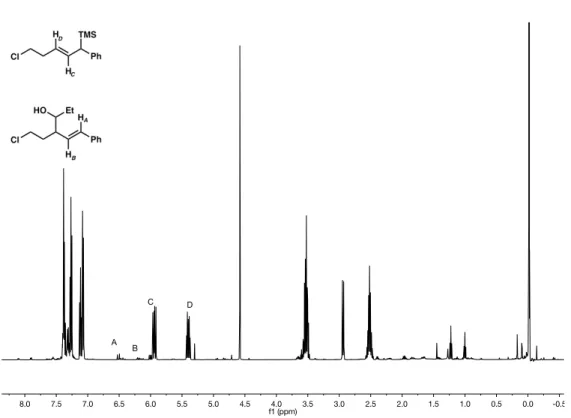
Substrate Scope
In contrast, the tandem allylation/cyclization method developed in this work proceeds through a linear transition state and is strongly affected by the steric nature of the molecule. This can be seen from the comparison of the yields of both methods with more substituted aldehydes. The same steric argument contributes to the moderate yields of using cyclohexane as the R group, although further investigation using different ring sizes suggests that there is more at play in this mechanism.
In contrast, we saw great success (96% yield of 120 ) using a long chain with a pendant chloride as the R group in the aldehyde. This provides interesting insight into the kinetics of cyclization, as the five-membered heterocyclic ring was preferentially formed. In the case of trans-2,3-tetrahydrofurans, the dr between trans to cis diastereomers improves as the distance of the benzyl group from the aldehyde increases.
Interestingly, as with tetrahydrofuran 127 , the benzyl group reverses the selectivity so that the cis product becomes the major diastereomer. In contrast, the presence of a benzyl group does not affect the diastereoselectivity of cis-2,3-tetrahydrofurans (124-126).
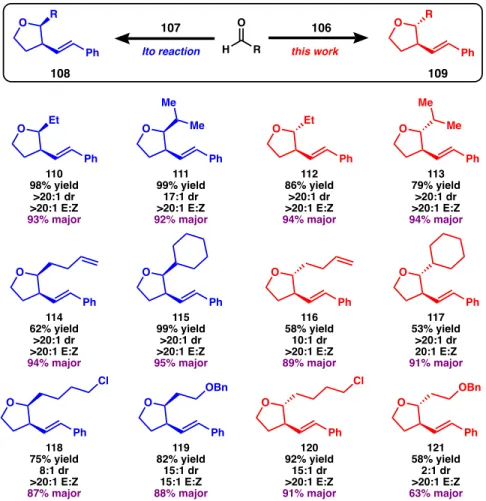
Conclusions and Future Directions
The benzyl group does not defuse in this transformation until four methylene units are incorporated into the aldehyde, as seen in tetrahydrofuran 129. Flash column chromatography was performed as described by Still et al.36 using silica gel (230-400 mesh) purchased from Silicon. 1 H and 13 C NMR spectra were recorded on a Bruker Avance III HD with Prodigy cyroprobe (at 400 MHz and 101 MHz, respectively).
Data for 1H NMR spectra are reported as follows: chemical shift (δ ppm) (multiplicity, coupling constant (Hz), integration). The flask was sealed with a new rubber septum, wrapped with electrical tape, and stirred at 5 °C in a cryocooler for 6 days. The crude reaction was diluted with Et2O and H2O, slowly quenched with 1 M HCl, and further diluted with water.
The aqueous layer was extracted with Et 2 O and the combined organic layers were dried with MgSO 4 , filtered and concentrated under reduced pressure. Then, 100 mg of oven-dried 3 Å molecular sieves were quickly added to the flask, which was subsequently evacuated and filled with argon. After stirring for 10 min, anhydrous KOtBu solution (2 mmol, 10 equiv, 1 M in THF) was slowly added to the flask via syringe, the reaction mixture was allowed to warm to room temperature and stirring was continued for 2 h.
The crude reaction was filtered through a plug of celite (ca. 4 cm in diameter and 1 cm thick), rinsed with 50 mL of Et 2 O, and concentrated under reduced pressure. TMSOTf (0.06 mmol, 0.03 equiv) was added to the flask and the reaction mixture was allowed to stir at room temperature for 5 min before being diluted with CH 2 Cl 2 (6 mL). The resulting powder was then loaded onto a silica column and purified via column chromatography to give the desired product.

